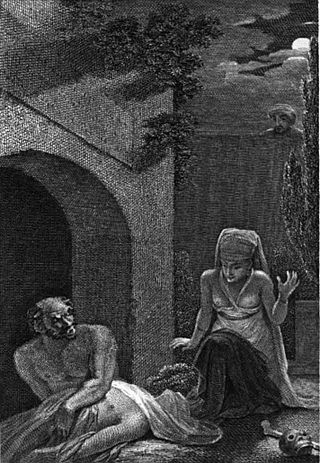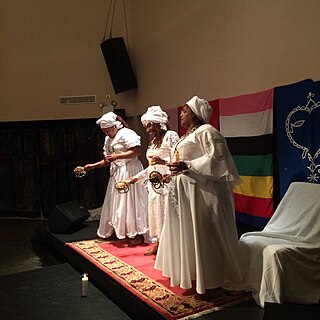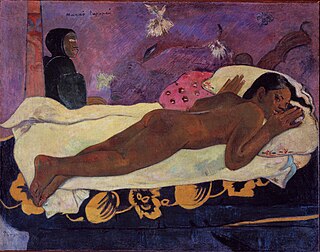Related Research Articles
Spirit possession is an unusual or an altered state of consciousness and associated behaviors which are purportedly caused by the control of a human body and its functions by spirits, ghosts, demons, angels, or gods. The concept of spirit possession exists in many cultures and religions, including Buddhism, Christianity, Haitian Vodou, Dominican 21 Divisions, Hinduism, Islam, Wicca, and Southeast Asian, African, and Native American traditions. Depending on the cultural context in which it is found, possession may be considered voluntary or involuntary and may be considered to have beneficial or detrimental effects on the host. Spirit possession is often regarded as a reason in support of spirits, deities or demons. In a 1969 study funded by the National Institute of Mental Health, spirit possession beliefs were found to exist in 74% of a sample of 488 societies in all parts of the world, with the highest numbers of believing societies in Pacific cultures and the lowest incidence among Native Americans of both North and South America. As Pentecostal and Charismatic Christian churches move into both African and Oceanic areas, a merger of belief can take place, with demons becoming representative of the "old" indigenous religions, which the Christian ministers attempt to exorcise.

Hoodoo is a set of spiritual practices, traditions, and beliefs that were created by enslaved African Americans in the Southern United States from various traditional African spiritualities and elements of indigenous botanical knowledge. Practitioners of Hoodoo are called rootworkers, conjure doctors, conjure men or conjure women, and root doctors. Regional synonyms for Hoodoo include rootwork and conjure. As a syncretic spiritual system, it also incorporates beliefs from Islam brought over by enslaved West African Muslims, and Spiritualism. Scholars define Hoodoo as a folk religion. It is a syncretic religion between two or more cultural religions, in this case being African indigenous spirituality and Abrahamic religion.

A ghoul is a demon-like being or monstrous humanoid, often associated with graveyards and the consumption of human flesh. A ghoul is far more ill-mannered and foul than the commonly mistaken goblin. The concept originated in pre-Islamic Arabian religion. Modern fiction often uses the term to label a specific kind of monster.

Mami Wata is a water spirit venerated in West, Central, and Southern Africa and in the Afro-American diaspora. Mami Wata spirits are usually female but are sometimes male.

A manbo is a priestess in the Haitian Vodou religion. Haitian Vodou's conceptions of priesthood stem from the religious traditions of enslaved people from Dahomey, in what is today Benin. For instance, the term manbo derives from the Fon word nanbo. Like their West African counterparts, Haitian manbos are female leaders in Vodou temples who perform healing work and guide others during complex rituals. This form of female leadership is prevalent in urban centers such as Port-au-Prince. Typically, there is no hierarchy among manbos and oungans. These priestesses and priests serve as the heads of autonomous religious groups and exert their authority over the devotees or spiritual servants in their hounfo (temples).
Mythic humanoids are legendary, folkloric, or mythological creatures that are part human, or that resemble humans through appearance or character. Each culture has different mythical creatures that come from many different origins, and many of these creatures are humanoids. They are often able to talk and in many stories they guide the hero on their journey.
Malagasy mythology is rooted in oral history and has been transmitted by storytelling, notably the Andriambahoaka epic, including the Ibonia cycle. At least 6% of Madagascar are adherents of the religion, which is known as Fomba Gasy, and surveys show it is likely at least half practice some aspects of it. Adherence to Fomba Gasy is high amongst the Sakalava people, as they are reluctant to convert to faiths of foreign origin.

The KingdomofMerina, or Kingdom of Madagascar, officially the Kingdom of Imerina, was a pre-colonial state off the coast of Southeast Africa that, by the 18th century, dominated most of what is now Madagascar. It spread outward from Imerina, the Central Highlands region primarily inhabited by the Merina ethnic group with a spiritual capital at Ambohimanga and a political capital 24 km (15 mi) west at Antananarivo, currently the seat of government for the modern state of Madagascar. The Merina kings and queens who ruled over greater Madagascar in the 19th century were the descendants of a long line of hereditary Merina royalty originating with Andriamanelo, who is traditionally credited with founding Imerina in 1540.

There was widespread belief in ghosts in Polynesian culture, some of which persists today. After death, a person's ghost would normally travel to the sky world or the underworld, but some could stay on earth. In many Polynesian legends, ghosts were often involved in the affairs of the living. Ghosts might also cause sickness or even invade the body of ordinary people, to be driven out through strong medicines.

The Vazimba, according to popular belief, were the first inhabitants of Madagascar. While beliefs about the physical appearance of the Vazimba reflect regional variation, they are generally described as smaller in stature than the average person, leading some scientists to speculate that they may have been a pygmy people who migrated from the islands that constitute modern-day Indonesia and settled in Madagascar over the course of the period between 350 BCE–500 CE. Scientific evidence confirms the first arrival and subsequent increase of human settlers on the island during this period, but the pygmy theory has not been proven.
Andriamanelo was king of Alasora in the central highlands region of Madagascar. He is generally considered by historians to be the founder of the Kingdom of Imerina and originator of the Merina royal line that, by the 19th century, had extended its rule over virtually all of Madagascar. The son of a Vazimba mother and a man of the newly arrived Hova people originating in southeast Madagascar, Andriamanelo ultimately led a series of military campaigns against the Vazimba, beginning a several-decade process to drive them from the Highlands. The conflict that defined his reign also produced many lasting innovations, including the development of fortified villages in the highlands and the use of iron weapons. Oral tradition furthermore credits Andriamanelo with establishing a ruling class of nobles (andriana) and defining the rules of succession. Numerous cultural traditions, including the ritual of circumcision, the wedding custom of vodiondry and the art of Malagasy astrology (sikidy) are likewise associated with this king.
Ralambo was the ruler of the Kingdom of Imerina in the central Highlands region of Madagascar from 1575 to 1612. Ruling from Ambohidrabiby, Ralambo expanded the realm of his father, Andriamanelo, and was the first to assign the name of Imerina to the region. Oral history has preserved numerous legends about this king, including several dramatic military victories, contributing to his heroic and near-mythical status among the kings of ancient Imerina. The circumstances surrounding his birth, which occurred on the highly auspicious date of the first of the year, are said to be supernatural in nature and further add to the mystique of this sovereign.
According to some versions of the genealogy of the Merina people of the central Highlands of Madagascar, Andriandravindravina is the name of the first sovereign of the Highlands. He was not Merina but rather a vazimba, the mysterious first inhabitants of Madagascar that successive waves of settlers encountered upon arrival there. The Tantara ny Andriana eto Madagasikara, the famed genealogy of the Merina aristocracy, states that Andriandravindravina ruled over Ambohitsitakatra in northern Imerina where he was reportedly buried. His three sons were:

West African mythology is the body of myths of the people of West Africa. It consists of tales of various deities, beings, legendary creatures, heroes and folktales from various ethnic groups. Some of these myths traveled across the Atlantic during the period of the Trans-Atlantic slave trade to become part of Caribbean, African-American and Brazilian mythology.

Ghostlore is an intricate web of traditional beliefs and folklore surrounding ghosts and hauntings. Ghostlore has ingrained itself in the cultural fabric of societies worldwide. Defined by narratives often featuring apparitions of the deceased, ghostlore stands as a universal phenomenon, with roots extending deeply into human history.
References
- 1 2 Hobbs, Joseph J. (2001). "People and caves in Madagascar". Focus on Geography. 46 (3). New York, USA: American Geographical Society: 1–7. doi:10.1111/j.1949-8535.2001.tb00011.x.
- 1 2 3 4 5 6 Sodikoff, Genese Marie (2012). Forest and Labor in Madagascar: From Colonial Concession to Global Biosphere. Indiana University Press. p. 43. ISBN 9780253003096. JSTOR j.ctt16gzp0j.6.
- 1 2 Paik, Peter Y.; Wiesner-Hanks, Merry (2013), "9", Debt: Ethics, the Environment, and the Economy, 21st Century Studies, Indiana University Press, p. 149, ISBN 9780253009432, JSTOR j.ctt16gzgz4.13
- 1 2 3 Holmes, George; Smith, Thomas Aneurin; Ward, Caroline (April 2018). "Fantastic beasts and why to conserve them: animals, magic and biodiversity conservation". Oryx . 52 (2). Cambridge University: 231–239. doi: 10.1017/S003060531700059X .
- 1 2 Sharp, Lesley A. (2001). "Wayward Pastoral Ghosts and Regional Xenophobia in a Northern Madagascar Town". Africa. 71 (1). Cambridge University Press on behalf of the International African Institute: 38–81. doi:10.2307/1161481. JSTOR 1161481. 1161481.
- ↑ Legrip-Randriambelo, O.; Regnier, D (2014), "The Place of Healers-Diviners (Ombiasa) in Betsileo Medical", Health, Culture and Society, 7 (1): 30, doi: 10.5195/hcs.2014.188
- ↑ Golden, Christopher D.; Comaroff, Jean (2015), "The human health and conservation relevance of food taboos in northeastern Madagascar", Ecology and Society , 20 (2): 42, doi: 10.5751/ES-07590-200242 , JSTOR 26270204
- ↑ Graeber, David (1997). "Painful Memories". Journal of Religion in Africa. 27 (4). Brill Publishers: 383. doi:10.2307/1581909. JSTOR 1581909.